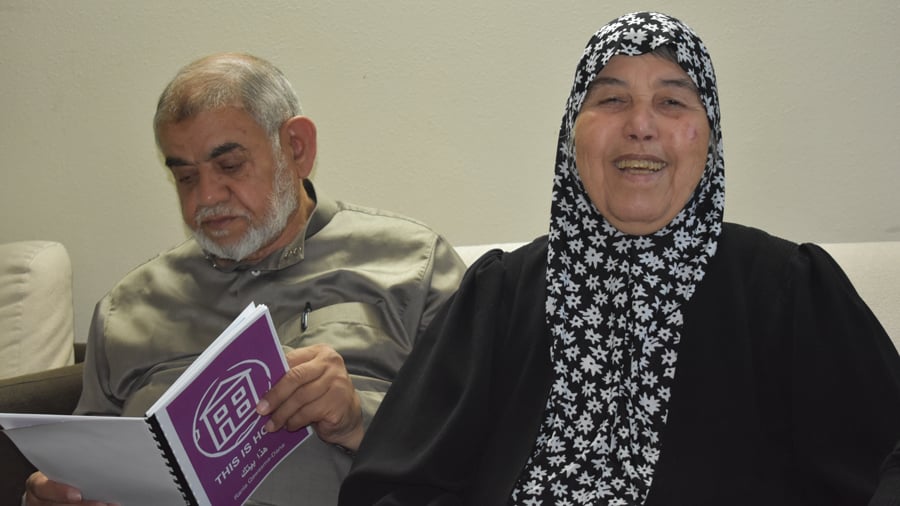
July 25, 2017
Designing for the Moment Refugees Become Neighbors
Seattle architect Rania Qawasma has created an award-winning guide for refugees navigating day-to-day life in American cities.
It wasn’t your average Saturday Seattle picnic. For one thing, everyone was speaking Arabic.
Architect Rania Qawasma, who grew up in the Middle East but had immigrated—for love—to the U.S., was seated among a group of recently resettled refugee families from Syria.
At the time, August 2016, Qawasma was mid-way through a remote-study masters program in sustainable design at Boston Architectural College (BAC), and she was still brainstorming her thesis topic. Her original idea had been to design an affordable housing complex for refugee populations. She had come to the park to observe and listen.
Not without laughter, the Syrian families reminisced about the culture-shock moments of their first weeks in America. One couple had immediately busted their garbage disposal—a device they’d never encountered—and had lived for a weekend with an overflowing kitchen sink. A mother confessed that she’d flooded her bathroom when she dumped out a bucket of soapy water for mopping, expecting the floor to have a drain like kitchens and bathrooms do in the Middle East. And parents were shocked when they angered some American neighbors by offering to share their own children’s candy with other kids at a local playground.
“These small incidents create a barrier,” says Qawasma, whose own memories of adapting to American culture were triggered that day. “You get the feeling you are not welcome because of small things, even though it’s not the American families’ fault or the Syrian families’ fault, it’s just misunderstanding.”
Qawasma thought a lot—with her sketchbook in hand, as architects do—about this idea of creating a “welcoming” environment, and decided she needed to ditch her original thesis plans.
She began sketching out what she called a “neighborhood guide,” a printed booklet that would, in a highly visual manner, help families navigate the pain points of assimilation. No English required. She just had one concern: her architectural thesis had no architecture at all. She called her thesis advisor, Portland architect Eric Corey Freed, who had a background in social design work, for his blessing.
Freed gave Qawasma a thumbs up, and the work began. Over the next year, Qawasma studied urban iconongraphy, infographics, travel guides, and language manuals. She was inspired most by the simplicity of signs and posters that used very little language to communicate key messages. She also told the refugee families what she was making and asked for their help.
“When Rania said she was going to make this book, I said, ‘Oh wow, please make it as soon as possible. I need it!’” says Yousif Al Asfar, a Syrian father of two who arrived in Seattle with his wife, children, and parents in January 2016. “Right away, I asked her, ‘Did you put the garbage disposal in your book?’ She laughed out loud.”
Qawasma had indeed tackled kitchen emergencies in her book, in the category “At Home,” which also included tips like not putting metal in microwaves and how to tell the difference between laundry and dish-washing soaps.
She had a section on shopping that advised new families on the difference between a supermarket, a big box store, a department store, and a drug store—all new information to refugees, many of whom are coming off years living in UNHCR-sponsored camps.
Qawasma made her first version of the guidebook in English and Arabic. “Everytime I designed a couple of pages, I’d bring them back to the families and see if they could understand it without asking questions,” she says. “The goal was for families to start feeling that they were independent and like they were part of this community.”
Her first version of the guide, which she titled This is Home, was 25 pages. But every time she collected feedback from resettled families and her advisor, the page numbers would go up. She added information about public transportation, the use of parks, healthcare, banking, and a “key words” section that was handy as an Arabic-to-English dictionary.
By the time Qawasma finished her thesis project proper, word about the usefulness of This is Home was spreading from Seattle to refugee resettlement agencies in other cities. Today, the guide has been translated into Spanish, Farsi, and Dari, and customized for hundreds of families in Riverdale, Maryland and in the Los Angeles area.
Michael Fiorillo, director of sustainable design at BAC, says the faculty felt so strongly about the utility of Qawasma’s project that in May 2017, they awarded it the institution’s top prize in sustainable design.
“She’s teaching people how to take the buses and how to use the infrastructure,” says Fiorillo. “It’s not separate from designing the built environment, it’s about navigating the built environment. Sometimes you have to respond to the need that’s in front of you.”
Qawasma’s own passion for the project has led to her further involvement in refugee and resettlement issues internationally. She’s teamed up with Architecture for Refugees, a Zurich-based association of design professionals, and in August, will launch an American chapter of the group, serving as its founder.
“It’s ongoing issue we need to tackle,” says Qawasma. “I’m not stopping.”
If you enjoyed this article, you might also be interested in Refugees Could ‘Save’ America’s Legacy Cities—Will We Let Them?
Recent Viewpoints
Viewpoints
Navigating the Path to Net Zero











